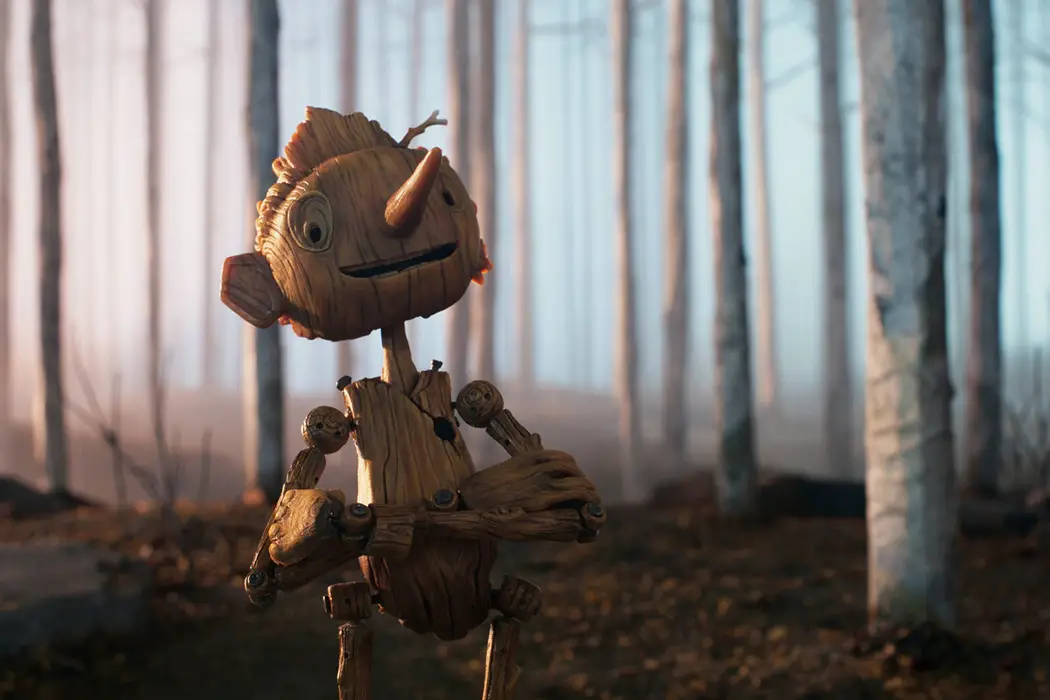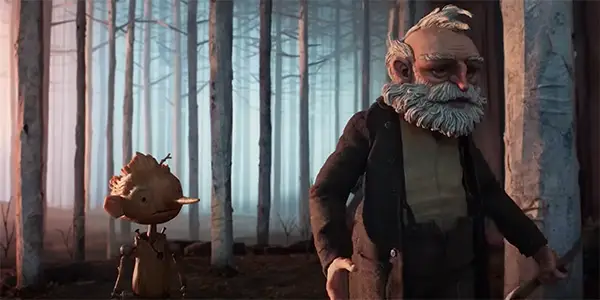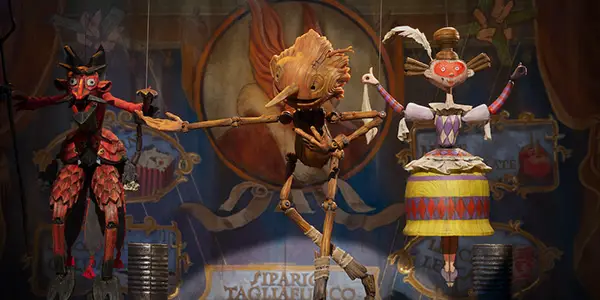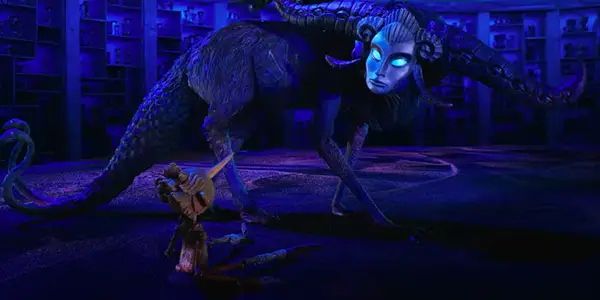PINOCCHIO: Guillermo del Toro Brings an Imaginative Vision to the Classic Story

David is a film aficionado from Colchester, Connecticut. He enjoys…
It’s been awhile since I’ve done one of these…like a long while. Life just has a way of catching up with you. But whenever a del Toro film comes along, I try to seize the opportunity to get back into writing. He’s one of my favorite modern directors, has a rather impressive oeuvre, and in recent years has received more awards attention with films like The Shape of Water and Nightmare Alley. Yet, as much as I love his movies and his devotion to his craft, I tend to be very critical of his work at the same time. Perhaps it’s a sign of how much I admire him; I know his potential, and that’s why I tend to nitpick every tiny detail of his films while also still appreciating them as a whole.
Nitpicking aside, though, Pinocchio is actually a delightful film. I enjoyed it more than his recent offerings, although there are still some things that don’t quite work. But even with its flaws and with the familiar, somewhat predictable story at its core, it still managed to both surprise and satisfy this long-term del Toro fan.
A Variation on the Tale
The film begins around the time of World War I. Geppetto (David Bradley) is a master woodcarver who is often commissioned for works around his small Italian town, including a giant replica of Jesus on the cross. His son Carlo (Gregory Mann) accompanies him on his work outings, and one day, unfortunately, he is killed by a stray bomb that was dropped by a passing plane. Geppetto mourns the loss of his son, planting a tree in his honor, and one day completely loses it and cuts the tree down to make a wooden replica of his son, also disturbing Sebastian J. Cricket’s (Ewan McGregor) home in the process.

A wood sprite (Tilda Swinton), hearing Geppetto’s mournful cries, decides to give the wooden puppet life, who she names Pinocchio. Geppetto is at first horrified by this small living wooden creature, and finds him a nuisance as Pinocchio increasingly gets into trouble, with little help from the reluctant Sebastian J. Cricket who is meant to act as his conscience. But along the way, Geppetto soon grows to care for the wooden boy. Pinocchio is also immortal; every time he dies he is brought to a place ruled over by the angel Death (also voiced by Swinton), who explains to him the rules, and indeed, burdens of everlasting life.
The Rise of Fascism
Coming within the same year; indeed, within just a few months of yet another Disney live-action adaptation (helmed by Robert Zemeckis and starring Tom Hanks, but both have done better), del Toro‘s Pinocchio still manages to stand on its own two feet. Where this adaptation differs is not only in its presentation, filmed in stop motion, but also the focus of the story itself. Taking place during the 1930s in fascist Italy (indeed, Mussolini himself even shows up at one point), it uses the fairy tale story as an allegory for this rising type of evil. Many characters throughout try to exploit the innocent Pinocchio, including Count Volpe (Christoph Waltz), who tries to swindle Pinocchio into joining his traveling circus, and the ruthless Podestà (Ron Perlman), who tries to get the immortal puppet to join his army.
These two characters, who also stand for or are an amalgamation of characters from the original story, represent something much greater: the two-tiered pulls of fascism itself. Pinocchio, as an original innocent (think the monster from Shelley’s Frankenstein, who del Toro was very much influenced by), is torn between wanting to do right by his father and also the allure of the two men that try to manipulate him, who promised him fame and fortune. In a way, the story is meant to be a representation of how dark forces are always pulling at us, with unrealistic promises or unfounded fears at their forefront, and, indeed, why it seems like it is happening even more today.
A Darker Fairy Tale
Much like some of del Toro‘s past films, such as The Shape of Water, The Devil’s Backbone, and Pan’s Labyrinth, del Toro uses the setting of a fairy tale, which is typically meant to invoke calm, in order to instill deeper, dark ideas. Fascism, as mentioned, is a large part of it, but it also gets at themes of mortality and sacrifice. Pinocchio’s immortality is a core idea at the film’s center, as are the deeper implications of what it means to live forever; likewise, it discusses what it means to have a short, mortal life. Themes of sacrifice are also present; indeed, one of the initial prominent images of the film are of a giant Jesus on the cross, not something you typically see in a kids’ movie.

Yet, this is where del Toro‘s film falls somewhat short, it doesn’t quite go far enough. Del Toro attempts to make the film both darker and also accessible to kids, yet as a result of it feeling safe, it falls much more to the kids’ side. It may be unexpected at times, even in a very specific choice towards the end of the movie, yet it still remains almost wholly predictable, which somewhat lessens the impact it could’ve otherwise had. At the end of the day, this is no Pan’s Labyrinth; yet, perhaps it doesn’t need to be. Del Toro is still a director with plenty of dark themes in his past work (see: Guillermo del Toro’s Cabinet of Curiosities, a Netflix show), so making more of a kid’s film isn’t necessarily such a bad thing.
That Animation, Though
We must also look at something unavoidably prominent within the film’s presentation: the animation itself. Filmed in stop motion by dozens of animators over the series of over 1,000 days, it is a stunning work. Admittedly, stop motion can be occasionally unnerving to me; the uncanny effect is real, and it’s somewhat hard to get accustomed to it in some films, perhaps intentionally such as in The Nightmare Before Christmas. But in Pinocchio, that was never the case. The film is incredibly fluid and devoid of the choppiness seen in some stop motion; after a time, you may not even notice that it is stop motion at all.
What makes the film’s animation standout is, ironically, the starkness of some of the imagery presented. Pinocchio himself is a squarish, unimposing figure, yet with the bouncy way he is animated (and also the cheery voice acting of the young Gregory Mann), he becomes lively and jubilant instead. Some of the sets are likewise simple, yet the coloring of the background, such as the vivid beauty of a sunset, and the precise lighting on the characters’ faces, makes the scenes come to life.

Some of the more impressive imagery comes from the fairy creatures, especially the character of Death, who is an imposing, neon-blue character with the features of many distinctive animals, including bull horns, multiple eyeballs across her head, and creepy snake heads on her tails. These images, coupled with some other more unsettling imagery, reflect on del Toro‘s longstanding fascination with macabre, otherworldly creatures.
The Sounds
The voice acting and score of Pinocchio also lend to its imaginative nature. For voice acting, the standouts are easily Ewan McGregor as the Cricket, who does a fine job as narrator, the young Gregory Mann as mentioned, Christoph Waltz as the charismatic Count Volpe, and the otherwordly vocals of Tilda Swinton as the two fairies. There are also a few del Toro regulars here, like Ron Perlman as the fascist government official.
Alexandre Desplat is also back as composer of the film, having previously done the Oscar-winning The Shape of Water. Pinocchio does actually share some elements in common with that film, with the main theme also being a light orchestral piece overlaid by piano, with just a tinge of something darker behind it. It sets the idyllic tone from the start, foreshadowing what’s to come.
Speaking of sounds, Pinocchio is also, at times unexpectedly, a musical. When Pinocchio first comes to life, for example, he jumps and dances around Geppetto’s house, smashing stuff like a child and singing a catchy song about it. The musical aspects only pick up a few more times throughout the film; basically, this isn’t the Disney adaptation by any means, but it is occasionally a delight when the characters suddenly break into song even if they hadn’t really done much of that previously.
Conclusion:
To conclude, Guillermo del Toro‘s Pinocchio is amongst his finer recent films as well as one of the more standout adaptations of the classic fairy tale. Del Toro‘s love for fairy tales, and indeed for this one specifically, remains clear, as does his passion for making movies in any form. As mentioned, the only way this film falls short is by not going even further into dark fairy tale territory; but as a result, the film remains accessible for people of any age. It’s a must-see for this holiday season.
Pinocchio is now streaming on Netflix.
Watch Pinocchio
Does content like this matter to you?
Become a Member and support film journalism. Unlock access to all of Film Inquiry`s great articles. Join a community of like-minded readers who are passionate about cinema - get access to our private members Network, give back to independent filmmakers, and more.
David is a film aficionado from Colchester, Connecticut. He enjoys writing, reading, analyzing, and of course, watching movies. His favorite genres are westerns, crime dramas, horror, and sci-fis. He also enjoys binge-watching TV shows on Netflix.













